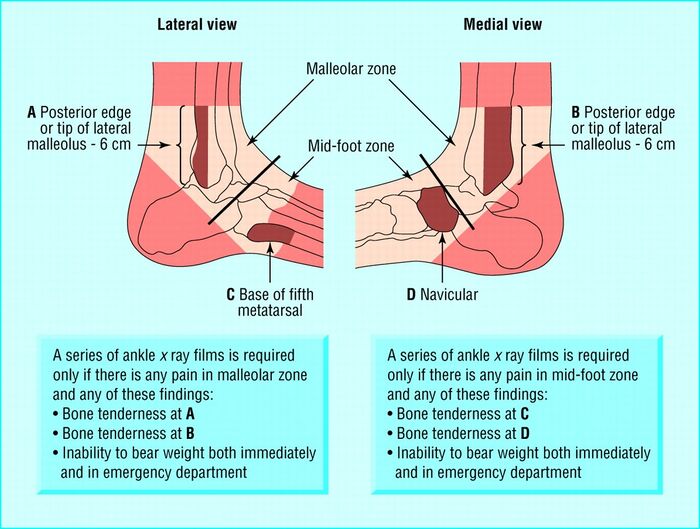◔
Ankle Sprain
From WikiMSK
This article is a stub.
Assessment
The Ottawa Ankle rule is an accurate instrument for excluding fractures of the ankle and mid-foot. Sensitivity is almost 100% and specificity is modest.[1]
Treatment
See Seah et al for a review on management.[2]
- Mild to moderate ankle sprain: functional treatment options are better than immobilisation on multiple outcome measures. Functional treatment consists of elastic bandaging, soft casting, taping, or orthoses, with association coordination training
- Severe ankle sprain: A short period of immobilisation in a below-knee cast or pneumatic brace results in a quicker recovery than tubular compression bandage alone.
- Lace-up supports are a more effective functional treatment than elastic bandaging and result in less persistent swelling in the short term compared to semi-rigid ankle supports, elastic bandaging, and tape.
- Semi-rigid orthoses and pneumatic braces provide beneficial ankle support and may prevent subsequent sprains during high-risk sporting activity.
- Supervised rehabilitation training in combination with conventional treatment for acute lateral ankle sprains can be beneficial, although some of the studies reviewed gave conflicting outcomes.
- There is probably a role for surgical intervention in severe acute and chronic ankle injuries, but the evidence is limited.
References
- ↑ Bachmann, L. M., Kolb, E., Koller, M. T., Steurer, J., & ter Riet, G. (2003). Accuracy of Ottawa ankle rules to exclude fractures of the ankle and mid-foot: systematic review. BMJ : British Medical Journal, 326(7386), 417-417. etrieved from http://www.ncbi.nlm.nih.gov/pmc/articles/PMC149439/
- ↑ Seah, R. et al (2011). Managing ankle sprains in primary care: what is best practice? A systematic review of the last 10 years of evidence. Br Med Bull, 97, 105-135. doi:10.1093/bmb/ldq028


